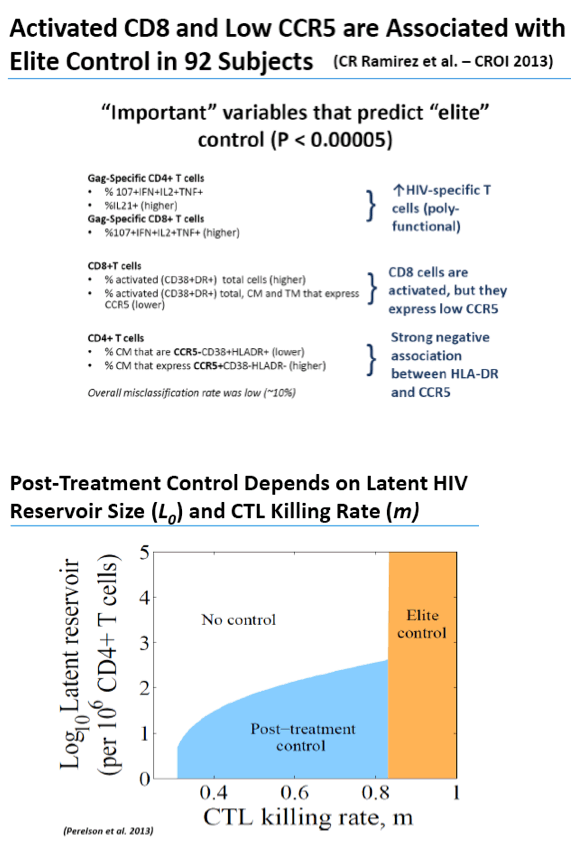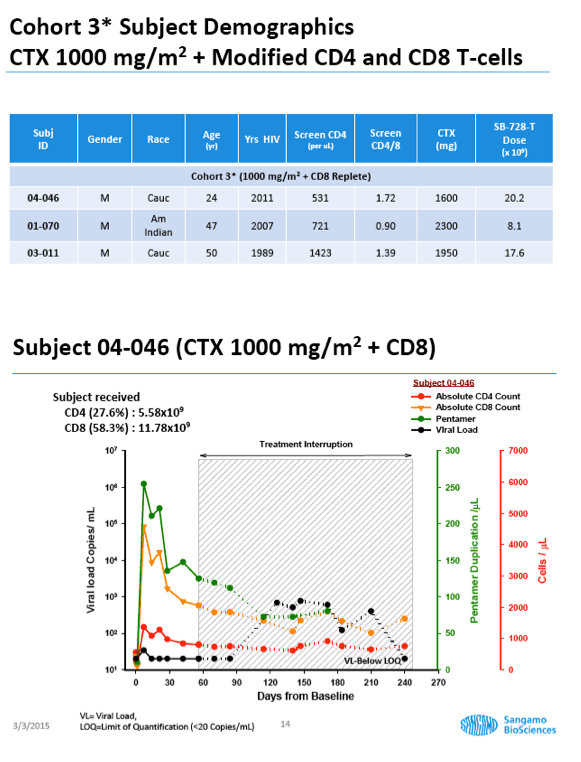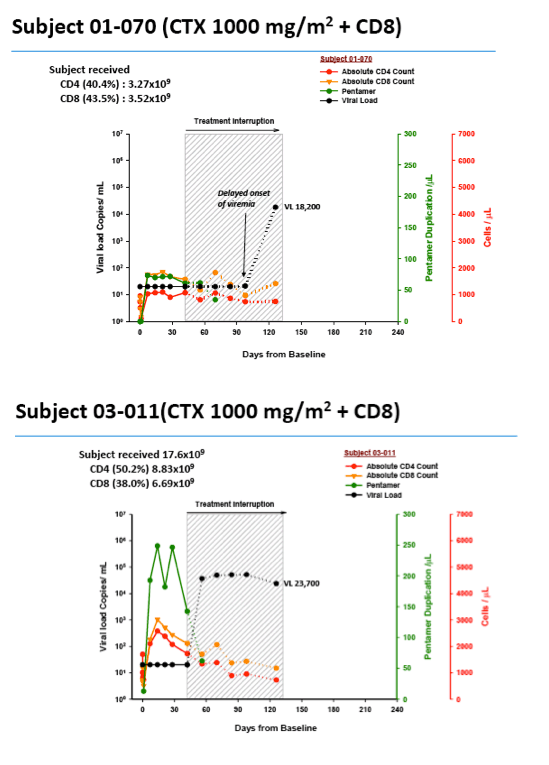 |
 |
 |
| |
A Dose Escalation Study of
Cyclophosphamide (CTX) to Enhance SB-728-T Engraftment
|
| |
| |
Reported by Jules Levin
CROI 2015 Feb 23-26, Seattle, WA
G Blick1, J Lalezari2, R Hsu3, E DeJesus4, T Hawkins5, R Mitsuyasu6, S Wang7, G Lee7, W Tang7and D Ando7
1Circle Care, Norwalk, CT; 2Quest Clinical Research, San Francisco, CA; 3NY, NY; 4Orlando Immunology Center, Orlando, FL; 5Southwest Care, Santa Fe, NM; 6UCLA, Los Angeles, CA; 7Sangamo BioSciencesInc, Richmond, CA
"Sangamo's SB-728-T therapy uses a zinc finger nuclease to alter CCR5 on T cells, which blocks the HIV virus' entry.. SB-728 is a ZFN-based approach for modification of the gene encoding CCR5, the major co-receptor used by HIV to infect cells of the immune system. Our first application is an autologous ZFN-CCR5-modified T-cell product (SB-728-T) which we are evaluating in an ongoing Phase 2 trial in Human Immunodeficiency Virus (HIV)-infected subjects."
CROI/2014: Cyclophosphamide Enhances SB-728-T (zinc fingers)
Engraftment to Levels Associated with HIV-RNA Control
http://www.natap.org/2014/HIV/041014_04.htm
ICAAC/2014: Virologic Response During ART Interruption After CCR5-Cell Modification With SB-728-T (zinc fingers)......HIV Protected AutologousZinc Finger Nuclease CCR5 Modified CD4 cells (SB-728-T) Reduce Viral Load (VL) in HIV Subjects During Treatment Interruption (TI): Correlates of Effect, and Effect of CytoxanConditioning......http://www.natap.org/2014/ICAAC/ICAAC_36.htm



------------------------
program abstract
Cytoxan Enhancement of SB-728-T Engraftment: A Strategy to Improve Anti-HIV Response
Primary Author:
Shelley Wang1, Gary Lee1, Winson Tang1, Dale Ando1, Gary Blick2, Jay Lalezari3, Ricky Hsu4, Erin DeJesus5, Trevor Hawkins6, Ronald Mitsuyasu7
2 CIRCLE CARE Center, Norwalk, Connecticut, United States;3 Quest Clinical Research, San Francisco, California, United States;4 Internal Medicine, New York University School of Medicine, New York, New York, United States;5 Orlando Immunology Center, Orlando, Florida, United States;6 Southwest Care Center, Santa Fe, New Mexico, United States;7 University of California Los Angeles CARE Center, Los Angeles, California, United States;1 Sangamo BioSciences, Inc., Richmond, California, United States
Abstract Body:
Background: Administration of CCR5 modified autologous CD4 cells (SB-728-T) is safe and well-tolerated and results in increases in total CD4 counts. The modified cells traffic to lymphoid tissues and have a selective survival advantage during ART treatment interruption (TI). Studies in CCR5 ∼32 heterozygote HIV subjects showed VL reductions during TI correlated with levels of engraftment of circulating bi-allelic CCR5-modified cells supporting the importance of maximizing engraftment of modified cells. We have previously presented preliminary data on the use of low dose cyclophosphamide (CTX) to enhance this process. We now report the final results of this dose ranging study.
Methods: A dose escalation study of IV CTX, with doses ranging from 100 mg/m2 to 2 g/m2 (n=3-6/cohort), administered 1-3 days prior to SB-728-T (>90% CD4, 500/uL.
Results: CTX was well tolerated with low grade GI side-effects at doses up to 1 g/m2. Grade 3 and 4 neutropenia requiring G-CSF developed at 1.5 and 2.0 g/m2 CTX. A dose-related increase in CD4 count and engraftment of bi-allelic CCR5 modified cells was observed with CTX doses up to 1 g/m2 but did not increase at 2.0 and 1.5 g/m2. By comparison, there was a progressive decline in CD8 cells with CTX dose escalation. Data in the table is expressed as Mean + SE; changes as Day 7 relative to pre-treatment baseline.
A 1-log VL reduction from peak was seen in 1 subject each at 100 and 500 mg/m2 of CTX while 1 subject each at the 1 and 1.5 g/m2 dose level had a 2-log decline during TI. At the conclusion of the study, 3 additional subjects were conditioned with 1 g/m2 of CTX and administered CCR5 modified T cells containing 40.5+5.6% CD4 and 46.9+6.4% CD8 T cells. CD8 count increased by a mean of 2590/uL at 7 days in the 2 subjects with data available for analysis. The VL in the first subject remains undetectable 5 weeks after TI initiation versus a median duration of 15+3 days in subjects who received only SB-728T.
Conclusions: CTX conditioning is well tolerated and was associated with increased engraftment of CCR5-modified T cells at doses up to 1 g/m2 in HIV subjects. CTX conditioning may be a useful strategy to maximize the engraftment and anti-viral effects of SB-728-T. The effects of co-administering CD8 cells with SB-728-T on VL will be presented.







|
| |
|
 |
 |
|
|